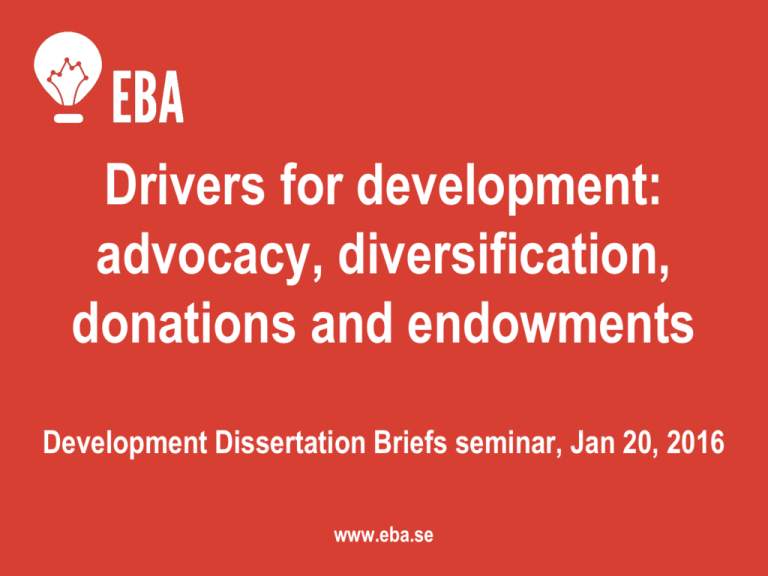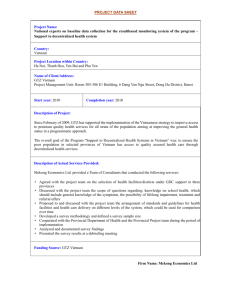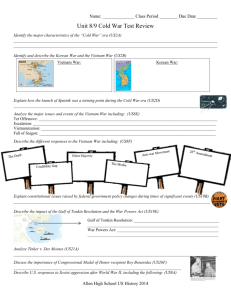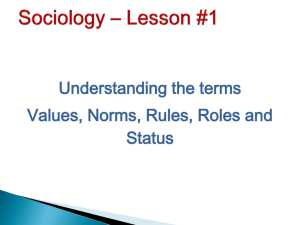Presentation
advertisement

Drivers for development: advocacy, diversification, donations and endowments Development Dissertation Briefs seminar, Jan 20, 2016 www.eba.se The when and why of helping: Individual and organizational decision making from a psychological perspective Arvid Erlandsson (Linköping University & Lund University) EBA Development Dissertation Briefs seminar series 20 January, 2016 Dissertation thesis • Written in the scientific framework of experimental psychology. • Focused on basic (not applied) research. • Focus on individual (not organizational) decision making in helping situations. • Key question: Which psychological factors are making people scopeinsensitive in helping situations? 3 September 2015 September 1st September 2nd 4 September 3rd When? Which aspects of the situation increased helping? Fund-raising campaign for fleeing refugees launched. Why? Which psychological mechanisms (i.e. feelings, thoughts, beliefs) can best explain the increased motivation to help? 250,000 SEK donated 250,000 SEK donated 4,000,000 SEK donated!!! WHY?: Three psychological mechanisms that can influence helping. 5 Emotional Reactions Perceived Effectiveness Perceived Responsibility ”I did not really feel much before, but I felt so intense emotions after seeing the picture so i just had to do something” ”Helping used to feel like a drop in the bucket, but now I believe that I am really making a huge difference for other people” ”I used to belieive that this was someone else’s problem, but now I realize that it is my duty to try to help those worse off.” WHEN?: The identifiable victim effect 6 WHEN?: The proportion dominance effect 7 WHEN?: The in-group effect 8 Do different mechanisms primarily underlie different helping effects? 9 Relevance for foreign aid decision makers? • Helping decisions made by politicians and by Sida officials are much more grand-scale than individual helping decisions. • Grand-scale helping decisions can be both about the magnitude of help (0.8%, 1.0%, or 1.2% of BNI to foreign aid) and about allocation of resources (Should project A or project B recieve funding?) . • Just as individual decision making, organizational decision making can be influenced by heuristics and biases, resulting in suboptimal decisions. • Being aware of common heuristics and biases is a good first step for reducing their influence on decisions. 10 How do we define effectiveness? Sida (2008): Glossary of Key Terms in Evaluation and Results Based Management 11 Which of these completed projects will be perceived as the most effective? 1) Project A which focused on the people worst of in the world and managed to help many of them. 2) Project B which had extremely low overhead costs meaning that hardly no money was used for unintended purposes. 3) Project C which focused on and succeeded in totally solving a smallscale problem. 4) Project D which maximized the amount of well-being per dollar spent. A shared definition of effectiveness is necessary (but not sufficient) if we want to evaluate the effectiveness of different helping projects. 12 13 Thank you! arvid.erlandsson@liu.se Essays on Child Education, Child labor and The Agricultural Economy Elin Vimefall Data • Kenya Integrated Household Budget Survey (KIHBS) 2005/2006 • 13430 households (66725 individuals) • Representative at national level but also at the urban/rural, provincial and district levels. Ethnolinguistic background and enrollment in primary education Setting: About 70 different languages Question: Does the probability of being enrolled in school differ among children with different ethnolinguistic background? Mechanism: Culture, norms, language. Findings: Ethnolinguistic background is important for explaining the child’s probability to be in school. Maasai and Somali children have a lower probability of being enrolled compared with children from all other groups Indication that gender norms are important Income diversification and working children Question: Does the household's’ income diversification strategy influences children’s probabilities of working and going to school? Mechanism: Income effect – less working children Substitution effect – more working children Findings: Children living in households that rely solely on the production from their own farm are about 3 percentage points more likely to work as their main activity and 2 percentage points less likely to be in school than other children. They also work more hours than other children. Income diversification among female-headed farming households Question: Does female headed households diversify their income in a different way compared to male headed households? Mechanism: Female headed household have been shown to have less education, labor, and productive assets as well as less acces to credit than male-headed households. This will limit their options for diversification. Findings: More dependent on transfers (28% compared with 14%) Higher probability of obtaining all earned income from production on their own farm. Less likely to diversify into non-agricultural wage work. Welfare impact of higher maize prices when allowing for price heterogeneity Question: What are the short-term welfare impact of higher maize prizes on different regions and socioeconomic groups in Kenya Setting: More than 90% of the farming households grow maize. However most households also buy maize in the market. Findings: About 80% of the population would be negatively affected if the price increased. Rural landless would lose the most. Main contribution: Relax the standard assumption that consumer and producer prices change in the same proportion and allow for heterogeneity in the marketing margin among districts. Path Dependent Possibilities of Transformation: Agricultural Change and Economic Development in North and South Vietnam MONTSERRAT LOPEZ JEREZ DDB Seminar, Stockholm, 20 January 2016 Disposition Vietnam as a starting point Motivation Main Findings Colonialism and Path Dependence Concluding Remarks Overarching Research Question How can the historical processes derived from the differences in factor endowments help us understand contemporary dynamics in the two Rice Deltas in Vietnam? Within the frame of agricultural (rice) economies López Jerez (2014) Deltas Apart- Factor Endowments, Colonial Extraction and Pathways of Agricultural Development in Vietnam Mekong River Delta - Red River Delta Vietnam Today: Miracle Economy Agriculture-led Transformation (Timmer, 2009) • De-collectivization Mean real per capita income 8000 7500 – North 7000 6500 6000 Thousand VND 5500 • Land use intensification 5000 4500 4000 3500 3000 2500 2000 1500 1000 500 0 1993 1998 2002 Rural North 2004 2006 Rural South Source: McCaig et al (2009) Difference South versus North: 14.3 vs 3.6% annual growth of crop income 2/3 vs 1/3 marketed output (1998) Impact in Inequality and Poverty – South: 10% Marginal Lands • Initial Conditions (Ravallion and van de Walle, 2008) • Why was the Southern farmer more able to take advantage? Why the Cochinchinese? Motivation • The dissertation: – Questions the explanatory power of the current factor endowments-colonial literature » Acemoglu, Johnson and Robinson (2001) – Acemoglu and Robinson (2012) » Engerman and Sokoloff (1997, 2002, 2005, 2012) – Develops alternative analytical framework to include: » Late colonisation » Indirect rule » Macro and micro levels » Causally related events and processes • For the Brief: – Which institutions are key for an inclusive economic transformation? – How could history matter for development today? Proposed Analytical Framework FACTOR ENDOWMENTS ECONOMIC GROWTH (SURPLUS GENERATION IN AGRICULTURE) INSTITUTIONS INCOME LEVELS AND DISTRIBUTION The Land Question Viet Cong “[T]he essence of the national problem is the farmer’s problem. The basic problem of the farmer is land. This is a strategic problem we can never neglect” (The South Vietnamese Communists and Rural Vietnam, 1966, in AID memo p 20) In comparison at the end of colonial period • The Red River Delta was more extractive than the Mekong • Large landholdings in the South than in the North • But the Red River Delta in Tonkin: Asian Bimodality? – Large concentration of ownership of land under cultivation in a small number of owners – Cultivation done by many farmers with access too little land and too fragmented • Mekong: Large estates, absentee landlordism, but tenant had possibilities of accumulation and market access – Vulnerability to market volatility – Imperfect markets (not least financial) The Institutional Dynamics • Colonial Institutions: are they a sufficient condition? • Village economy and its institutions – Open versus closed village – Moral Economy (Scott, 1976) versus Rational Peasant (Popkin, 1979) • Bringing the actors into the focus: – Irma Adelman (1986): the distribution of assets, the institutions for asset accumulation, and the institutions for access to markets interact when new economic opportunities arise Linking Past to Present • Is this story of path dependence? – North, yes, but not due to institutions but factor endowments and the significant land fragmentation » Currently, eight or nine non-contiguous plots often no larger than 200 to 500 square meters each (WB 1998) » In 1938, 1938: 1,229,200 ha, divided into 13,793,000 parcels, which were less than 0.089 ha on average (1,453,400 proprietors ) » Impossibilities of economies of scale associated with new technologies » High economic and political transaction costs – South: more complex, but not a la E&S or AJR’s » Are colonial “extractive” institutions a sufficient condition? Thank you! Montserrat.lopez_jerez@ekh.lu.se How Extractive? Inequality Possibility Frontier and Extraction Ratio Milanovic, Lindert, and Williamson (2007) ’Measuring Ancient Inequality‘ •Two groups in society •Between classes inequality (Gini) •Assumptions on income distribution: • Guarantee subsitance minimum for the poorer classes • Remaining = Surplus for the richer classes •Δ Average Incomes Δ Surplus Δ Potential Inequality (Maximum Feasible Inequality) •Extraction ratio = ActualGini Source: Milanovic et al (2007: 79) MaxFeasibleIneq GDP (1990 PPP) Figure Appendix GPD per Capita in Tonkin and Cochinchina Source: Author’s based on Bassino (2000) Tonkin Rice Production Possibility Frontier Tonkin Other Produce HLET Surplus Involution IPF and ER * Tonkin 1936 * Tonkin 1931 Cochinchina IPF and ER Rice Production Possibility Frontier Cochinchina up to 1930s * Cochinchina 1930 * Cochinchina 1936 Other Produce • Processes: – – – – – A formation of a (Viet) landed elite Under labour shortage and a mobile land factor Improvements in stratification and more inclusive growth Incentives and Opportunities to access and accumulation Debt crisis – polarization and subsistence Lorenzt Curve – Initial Land reforms Land Inequality in 1955 and 1966 1 0.9 0.8 0.7 0.6 0.5 0.4 0.3 0.2 0.1 0 0 0.1 0.2 0.3 0.4 Land Distribution 1955 0.5 Equality 0.6 0.7 Land Distribution 1966 Source: Data for land owners taken from Bredo et al (1968), estimates of landless in Callison, (1974, table A-1 and table A-2, pp. 359-360). 0.8 0.9 1 Colonial Debate – AJR XIX C 1500 1995 Low Pop. Density = Relative Poorer European Settlement Prop. Rights for Broad Cross Section Better Economic Performance High Pop. Density = Relative Richer No European Settlement Extractive Institutions (Reversal) Worse Economic Performance Colonial Debate – Engerman & Sokoloff Factor Endowments Colonial Institutions Equality of Opportunities Economic Performance High Man to Land Ratios Plantation Economies Inequality of Opportunities Institutional Development Paths Civil society engagement in the governance of transboundary rivers Formal rules, informal norms and NGO advocacy strategies A case from the Mekong river Yumiko Yasuda (PhD) 20 January 2016 EBA Seminar Research background and objectives • Background – Civil society actors are key agency in water governance – Many studies focusing on Roles, strategies, approaches, actions of civil society actors in their attempt to influence rules and norms. But limited studies analyzing how norms and rules influence NGOs’ strategies. • Objectives – Understand how formal rules and informal norms affect advocacy strategies of civil society actors. – Identify opportunities and barriers civil society actors face in the context of transboundary water governance. Research methodology: Comparative case studies of 2 NGO coalitions in the Mekong • Advocacy strategies associated with the Xayaburi hydropower dam, on the Mekong River. • Study period: September 2010August 2012. Procedure for Notification and Prior Consultation and Agreement(PNPCA) process. • Comparative cases: – Rivers Coalition in Cambodia (RCC) – Vietnam Rivers Network (VRN) The Xayaburi dam PNPCA process Year/Moth Key Events 2010/Sept Lao PDR expressed its intension to build the Xayaburi dam. 2010/Oct Strategic Environmental Assessment of 12 mainstream hydropower dams 2011/Feb& March Public consultation in Cambodia, Vietnam and Thailand (not in Lao PDR). EIA was not publicly available at theConcession time of consultation agreement signed No agreement reached at the MRC Joint Committee (2011/3) after 6 months consultation period. The decision was deferred to the Council level. Electricity purchase 2011/April 2011/Dec MRC Council meeting suggests to conductagreement further transboundary signed impact assessent (2011/10) Xayaburi official launch (2012/11) Key findings • 4 types of advocacy strategies were identified, depending on target audiences – Targeting Mekong regional decision-makers – Targeting national decision-makers – Targeting stakeholders in affected areas – Targeting general public Cambodia: RCC’s Key strategies • Strategy targeting regional decision-makers: participating to activities initiated by regional coalitions of NGOs. • Many activities targeting stakeholders in affected areas. Awareness raising events and thumb prints petitions. Photo: RCC 2012 Influence of rules and norms on RCC’s strategy targeting stakeholders in affected Biophysical & Material areas conditions: Cambodia’s plans for hydropower dams on the mainstream of the Mekong River. . Formal rules: Policies and laws on decentralization. Informal rules and norms: Taboo in criticising people who gained higher social status (Theravada Buddhism) Neo-patrimonialism. Fear of authorities. Interactions: Informal pressure not to speak up against authorities and development. NGOs’ needs for maintaining positive relationship with local authorities. Actors: CPP. Local authorities. RCC member NGOs (mix of advocacy and development-focused organizations). Strategies: RCC’s cautious approach in raising the issue of hydropower dams. Modification of planned activities. Some RCC/community members did not take part in thumb print activities. Vietnam: VRN’s key strategies • Primarily targeting national decision-makers, scientists and media • Close collaboration with government, conducting joint workshops • Use of informal meetings • Use of media Influence of rules and norms on VRN’s media strategy targeting general public Biophysical &Material conditions: Territorial disputes between Vietnam and China. Formal rules: Law on Media. Penal code. Constitution. Informal rules and norms: Informal guidance from CPV and the Ministry of Culture and Information on what can be in the media. Interaction: Media embargo on the Xayaburi dam Strategies: VRN faced restrictions in media strategy Actors: CPV. Ministry of Culture and Information. Journalists. Competition between Vietnam and China over influence in Laos. Conclusion – Formal and informal rules and norms influenced advocacy strategies through interacting complementary at times, and competing at other times. – Actors played important roles in determining types of interactions. – Analytical framework developed for this research could serve as a useful tool for future analysis of and by NGOs and civil society actors on influence of formal and informal rules and norms. – Lack of pathways for civil society engagement in decision-making in the context of transboundary water. Existing legal tools for public participation in the governance of transboundary rivers • Aarhus Convention:Rights of citizens to participate to environmental decision-making regardless of the nationality • ESPOO Convention: Requires parties to allow citizens to participate to transboundary Environmental Impact Assessment • UN Watercourses Convention: Individual right to claim compensation for significant harm, regardless of nationality. Thank you and more information • Summary of the research is published as EBA dissertation brief in 2016. • Full research published in 2015: ‘Rules, Norms and NGO Advocacy Strategies: Hydropower Development on the Mekong River.’ (Earthscan Studies in Water Resources Management Series by Routledge Taylor/Francis group) • For more information, please contact yumikoyasuda@gmail.com






